
 Image: IDG / Chris Hoffman
Image: IDG / Chris Hoffman
At a glance
Expert’s Rating
Pros
Windows and Android in one deviceA better “2-in-1” experience than the average 2-in-1Decent PC performance with good build quality
Cons
ExpensiveAttaching the screen feels a little clunkyVery few portsA separate Windows laptop and Android tablet may be more convenient
Our Verdict
This machine combines a Windows laptop and Android tablet. It’s expensive, but there’s nothing else like it.
Price When Reviewed
This value will show the geolocated pricing text for product undefined
Best Pricing Today
Price When Reviewed
$3,518
Best Prices Today: Lenovo ThinkBook Plus Gen 5 Hybrid
RetailerPriceLenovo$3518View DealPrice comparison from over 24,000 stores worldwideProductPricePrice comparison from Backmarket
The Lenovo ThinkBook Plus Gen 5 Hybrid (Station & Tab) is truly a 2-in-1 laptop, combining a 14-inch Windows laptop and an Android tablet in one unusually interesting form factor. You can detach this laptop’s screen and use it as an Android tablet. Or you can press a button on the keyboard to instantly swap between Windows laptop and Android laptop modes.
Yes, this really is two computers in one. You can even plug the base of the laptop (aka the Station) into an external monitor and use it separately from the screen while the screen (aka the Tab) functions as an independent Android tablet. Plus, Lenovo includes a stylus and an easel stand for this machine.
There’s a lot going on here. I’m happy this machine exists – it feels like the type of product I’d see at a tech show like CES or IFA, where the hardware manufacturer would say it’s an experimental device that isn’t planned for a real release. But this is a real machine that Lenovo is selling today and that’s awesome, even if the $3,500 price point will be more than many people will want to spend.
Further reading: Best laptops 2024: Premium, budget, gaming, 2-in-1s, and more
Lenovo ThinkBook Plus Gen 5 Hybrid: Specs
The Lenovo ThinkBook Plus Gen 5 Hybrid includes an Intel Core Ultra 7 155H CPU. This is one of Intel’s Meteor Lake CPUs. With Lunar Lake on the horizon, it’s important to note that this machine doesn’t have a fast enough NPU to get Copilot+ PC features, if that’s important to you. Lunar Lake-powered systems will also likely have much better battery life and performance – if you believe Intel’s promises. (We haven’t had a chance to benchmark them yet).
You’re also getting 32GB of RAM along with Intel Arc graphics. It’s a reasonable setup, although people who want more powerful discrete graphics for gaming or content creation work will need to look elsewhere.
I’ve included the specs of the base station – the Intel Windows PC — in the below list. The ThinkBook Plus G5 Tab has its own hardware: A Qualcomm Snapdragon 8+ Gen 1 processor, Qualcomm Adreno GPU, 12GB of RAM, and 256GB of storage. It also has its own 38.7 Watt-hour battery.
CPU: Intel Core Ultra 7 155HMemory: 32GB LPDDRX5 RAMGraphics/GPU: Intel Arc graphicsDisplay: 2880×1800 OLED display with 60Hz refresh rateStorage: 1 TB SSDWebcam: 1080p webcam with physical shutter switch on the front, 13MP autofocus camera on the backConnectivity: 2x USB Type-C (Thunderbolt 4 / USB4), 1x combo audio jackNetworking: Wi-Fi 6E, Bluetooth 5.3Biometrics: IR camera for facial recognition, fingerprint reader (in the power button)Battery capacity: 75 Watt-hours for Station, 38.7 Watt-hours for TabDimensions: 0.63 x 12.3 x 9.2 inches combined (0.37 x 12.3 x 9.2 inches for Station and 0.26 x 12.3 x 8.8 inches for Tab)Weight: 3.87 pounds combined (2.14 pounds for Station and 1.73 pounds for Tab)MSRP: $3,518 as tested
The Lenovo ThinkBook Plus Gen 5 Hybrid is a very cool machine. I’m glad Lenovo is creating interesting and unique experiences like this one and bringing them to market.
Lenovo ThinkBook Plus Gen 5 Hybrid: Design and build quality
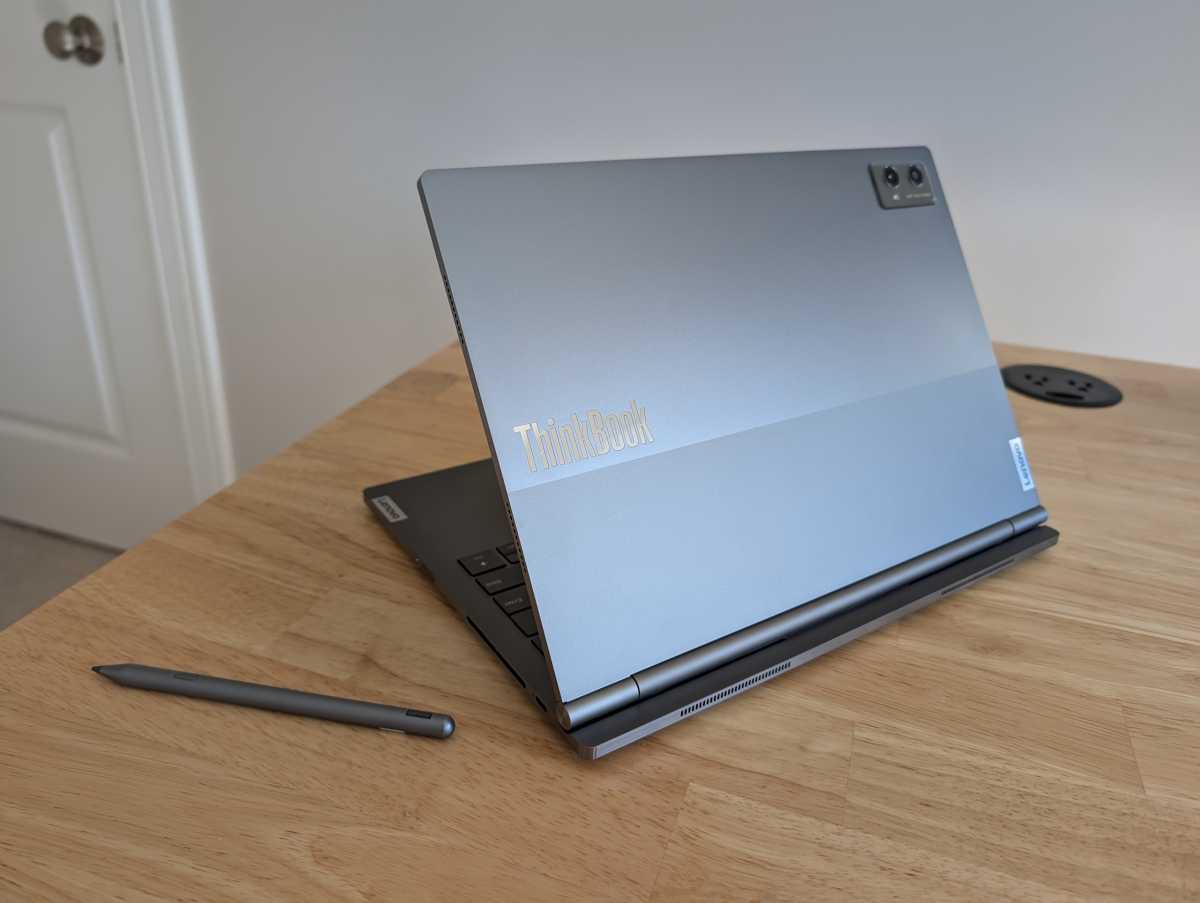

IDG / Chris Hoffman

IDG / Chris Hoffman
IDG / Chris Hoffman
The Lenovo ThinkBook Plus Gen 5 Hybrid has a smart design. It’s incredibly solid, made out of silver and gray aluminum with a very dense feeling. At 3.87 pounds, it’s heavier than the average “thin-and-light” 14-inch laptop. That’s no surprise, as this machine includes two separate computers. There’s much more weight in the screen than there is in an average laptop – that has to be the case, as the screen can function as an Android tablet when detached from the device.
I’m a big fan of the design overall. The average 2-in-1 laptop simply has a hinge that can rotate 360 degrees. So sure, you can rotate it back, but then you’re using an incredibly heavy tablet and you feel the keyboard’s keys on the back of the tablet. With this machine, you just pop the display off: Rotate the screen so that it’s at a 90-degree angle relative to the keyboard, and then pull the screen up and away from the base station.
The mechanism that attaches the screen to the base station of the laptop is incredibly solid, and the hinge works smoothly while it’s attached. The weight of the screen isn’t a problem for the hinge. This is a more solid hinge than you’ll find on the average laptop.


IDG / Chris Hoffman

IDG / Chris Hoffman
IDG / Chris Hoffman
Still, there’s a problem I have to highlight: The display-attaching process doesn’t quite feel like I think it should. When I received the laptop, I attached the screen to the base station by snapping it into place. The screen didn’t stay fully closed. Lenovo informed me that this was because the display wasn’t securely attached to the base station. To attach the display to the base station, I had to press down much harder than I expected until it snapped into place.
The mechanism did seem to break in over time, becoming easier to attach — and with less force — than it was the first time I used it. But, weeks later on my review unit, I still had to press down separately on the right side of the screen and then on the left side to make each side snap securely into place.
It’s not a huge problem once I got a feel for how to attach it, but ideally it would work more smoothly. That being said, I still prefer this detachable screen to a 2-in-1 experience that requires your fingers are resting on a keyboard on the back of a screen.
Unlike other 2-in-1 machines like Microsoft’s Surface Pro, you’re also getting a full Android environment when the screen is detached. That’s a big deal – while I love Windows, we all know that Android is a more touch-optimized environment that has more touch-first tablet applications.
The main issue with using this machine as an Android tablet is the screen size. That 14-inch 16:10 screen is great in laptop mode. However, in tablet mode, it’s unusually large and perhaps a little unwieldy.
Lenovo also includes an easel-style stand for this machine along with an active pen, however. That’s a hint that this machine is more designed for content creation, even in tablet mode.
Lenovo ThinkBook Plus Gen 5 Hybrid: How does the Android integration work?
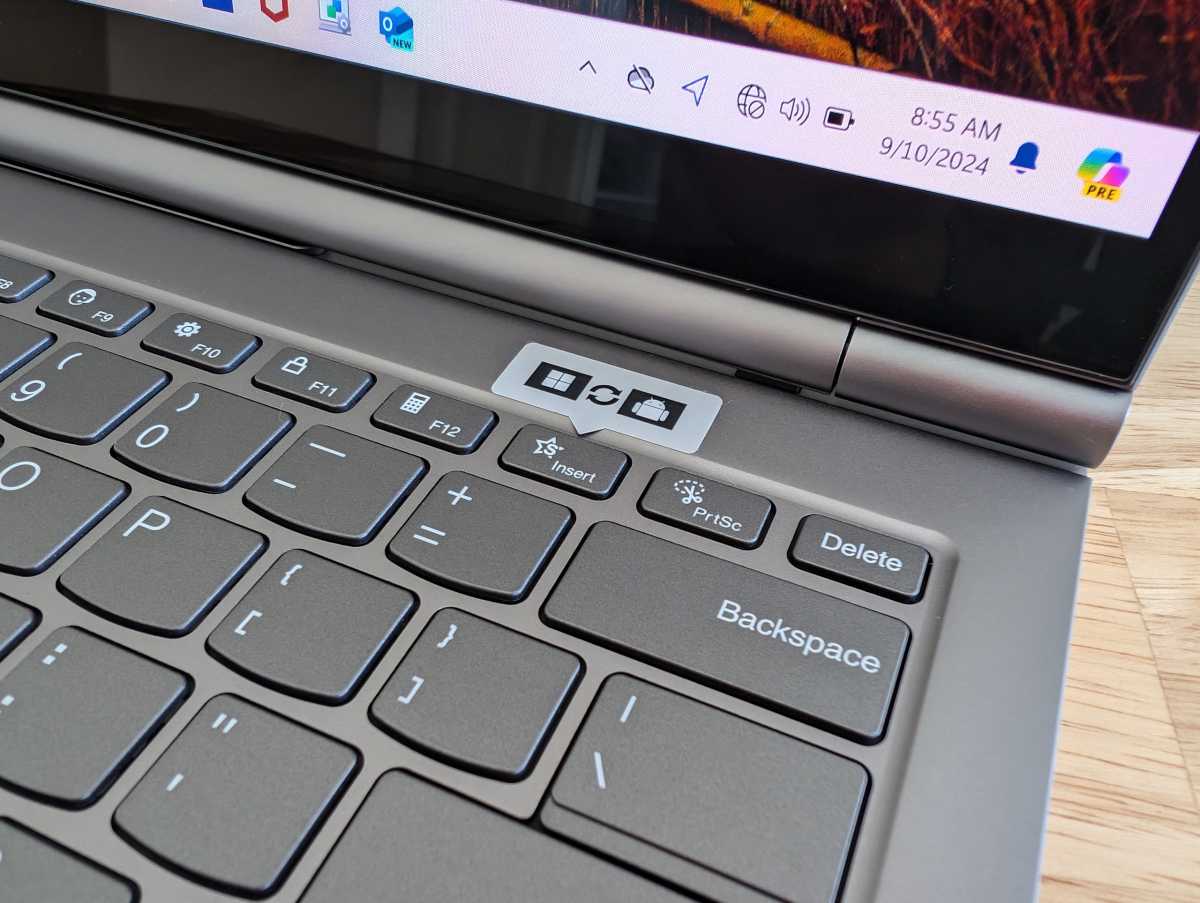

IDG / Chris Hoffman

IDG / Chris Hoffman
IDG / Chris Hoffman
You can detach the ThinkBook Plus Gen 5 Hybrid’s screen to have it function as an Android tablet. (You can’t use the screen as a separate Windows tablet, though: The Windows PC hardware is in the base of the laptop while the Android hardware is in the display).
You can also use this machine as an Android laptop. The keyboard has a special function key where the Insert key is. Marked by a sticker that comes on the laptop, this key will swap between Windows mode and Android mode. It takes one or two seconds to swap between environments, like if you were flipping an internal KVM switch to switch between devices. I’ve never used a laptop that ran two operating systems at once and let me switch between them at the press of a key. It’s a neat idea.
Lenovo also bundles software that lets you access the Android environment in a window on your Windows desktop. You’re able to run Android software in a window without emulation – it’s running right on the hardware in the display part of the machine. A Hybrid Center application included with the PC provides one place to set things up and learn how to use these hybrid features.
The Windows PC and Android system have separate storage. To ease file transfers, Lenovo bundles Hybrid Folder software. Once you pair the Windows and Android sides of the laptop, changes you make to this folder – including files you add and remove – will by synced to the other machine. It can even sync wirelessly if the Gen 5 Hybrid’s screen is removed.
It works pretty well, but it’s once again a reminder that this Hybrid machine is two separate computers: A Station and a Tab. For example, if you’re connecting to a Wi-Fi network, you’ll need to enter the network’s passphrase in both Windows and Android to use it in each environment. Settings like this don’t sync between each system.
Lenovo ThinkBook Plus Gen 5 Hybrid: Keyboard and trackpad
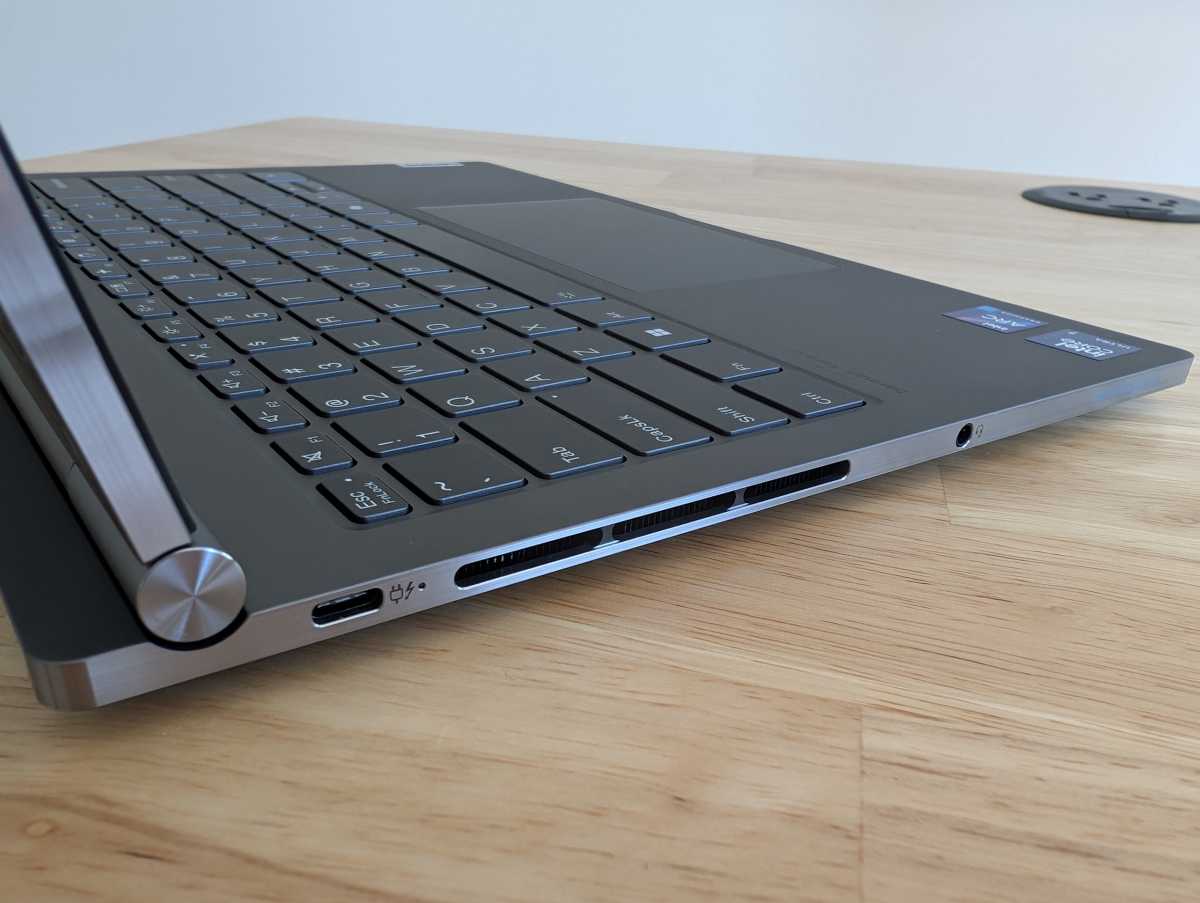

IDG / Chris Hoffman

IDG / Chris Hoffman
IDG / Chris Hoffman
The full-size keyboard on the Lenovo ThinkBook Plus Gen 5 Hybrid works well, both in Windows laptop mode and Android laptop mode. It’s a high-quality keyboard. I feel like I’ve used snappier laptop keyboards with crisper key action, but I had no problem sitting down at the laptop and accurately typing at a high speed.
This machine’s trackpad also works well. It’s plenty large, the click action feels pleasantly clicky, and the surface is smooth to the touch. Palm rejection worked well while I was typing. It’s not quite as nice as new haptic touchpads found on machines like Microsoft’s Surface Laptop 7, but those aren’t widespread yet.
Lenovo also includes a pen with this package. It works in both Android and Windows, and it can attach magnetically to the lid of the laptop.
Lenovo ThinkBook Plus Gen 5 Hybrid: Display and speakers
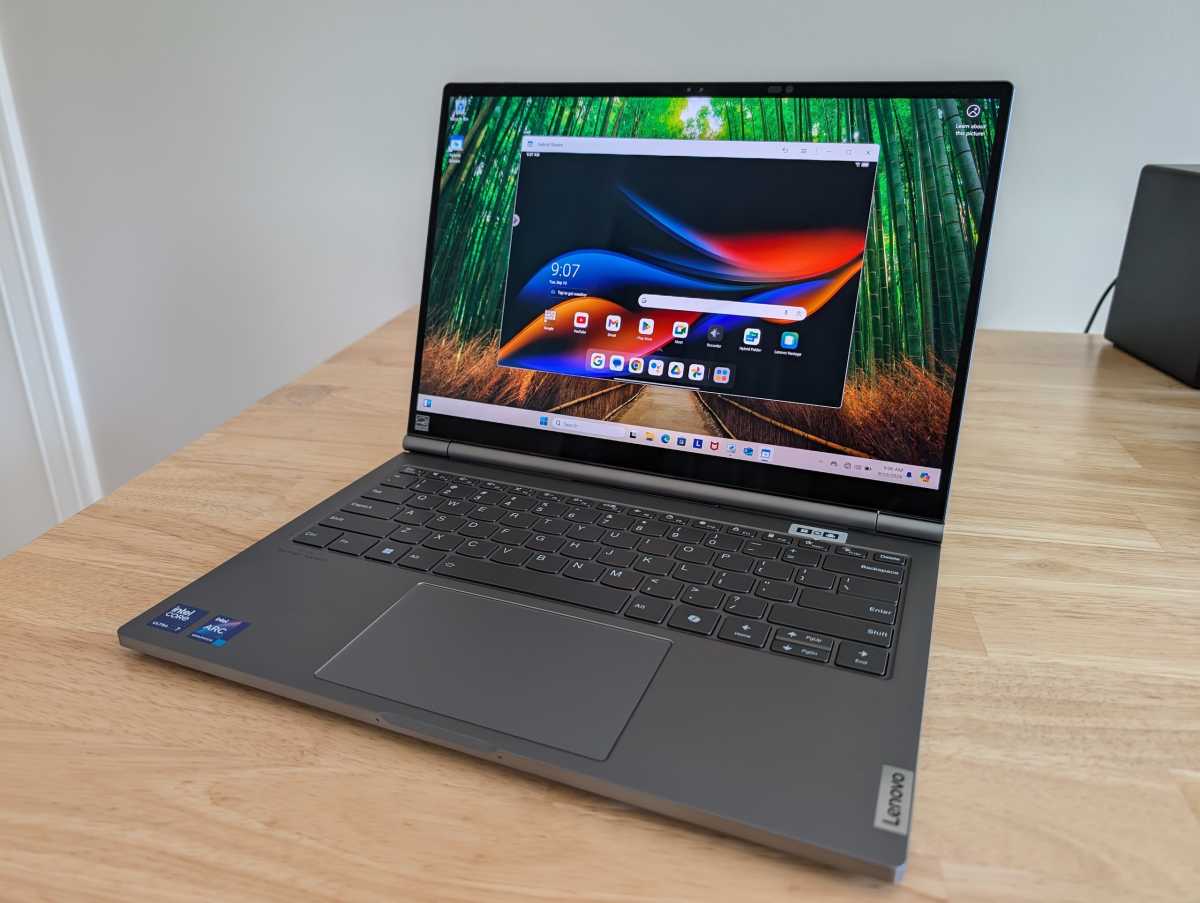

IDG / Chris Hoffman

IDG / Chris Hoffman
IDG / Chris Hoffman
The Lenovo ThinkBook Plus Gen 5 Hybrid has a 14-inch 2880×1800 OLED display with a 60Hz refresh rate. Naturally, this is a touch screen and the touch screen functions in both Windows and Android modes.
The screen looks beautiful, which is no surprise for a 2.8K OLED display. However, some displays do have higher refresh rates than 60Hz. Though it’s a glossy display, it had enough brightness to work well outside on a sunny day.
The Station and Tab have separate speaker systems here. In laptop mode, you’re getting the best speaker setup — no surprise there. This machine can output a surprising amount of volume while the audio remains clear, and it has decent bass for a 14-inch laptop, too.
Lenovo ThinkBook Plus Gen 5 Hybrid: Webcam, microphone, biometrics
The Lenovo ThinkBook Plus Gen 5 Hybrid has a 1080p webcam integrated into the Tab portion – the screen, in other words. It’s a solid webcam that produces a good picture. You also get access to the AI-powered Windows Studio Effects for features like background blur and faked eye contact in any application.
There’s also a physical shutter switch above the webcam that blocks the webcam, which is always a nice privacy feature.
This machine also has a dual-camera array on the back, just like a smartphone would. It’s a 13MP auto-focusing camera along with a 5MP wide camera with a flash. This feature doesn’t just work in Android – it’s also accessible in apps like the Camera app on Windows. It probably won’t replace your smartphone camera – modern high-end smartphones have cameras with more megapixels. But it’s nice to have and it’s the kind of feature included with tablets.
The microphone sounds good and picked up my voice well even in an environment with a good amount of background noise. Between that and the webcam, this is a great machine for online meetings.
The Lenovo ThinkBook Plus Gen 5 Hybrid includes both an IR camera for facial recognition and a fingerprint reader. The fingerprint reader is part of the power button at the right side of the laptop. Both worked well — and the machine also offers facial recognition for signing into the Android tablet environment.
Lenovo ThinkBook Plus Gen 5 Hybrid: Connectivity
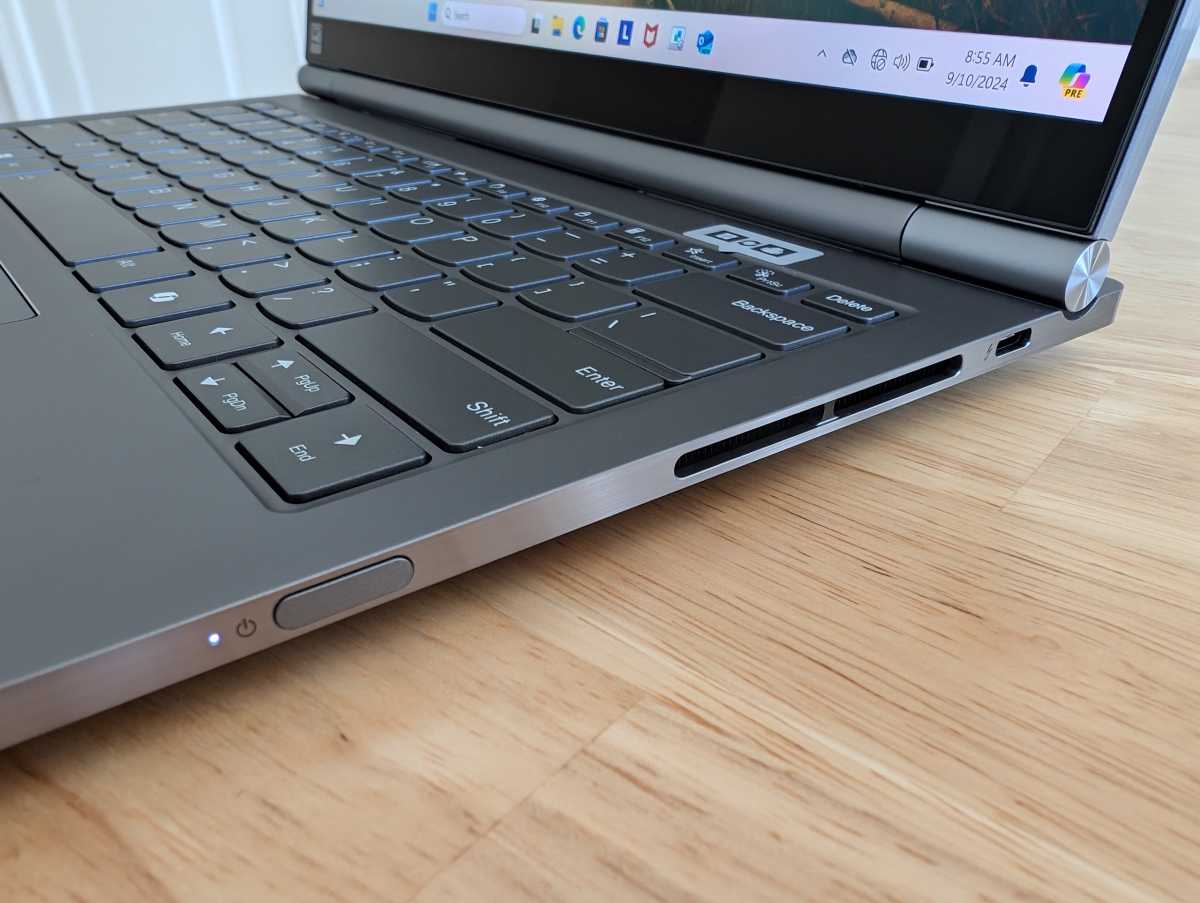

IDG / Chris Hoffman

IDG / Chris Hoffman
IDG / Chris Hoffman
The connectivity options on the Lenovo ThinkBook Plus Gen 5 Hybrid are somewhat minimal. You’re getting two USB Type-C ports – one on the left, and one on the right. You’ll use one of these ports to charge the laptop. You’re also getting a combo audio jack port on the left. That’s it.
When the screen is detached from the base station and functioning as an Android tablet, you’ll get one USB Type-C port on the screen. This provides a way to charge the tablet and connect devices to it even while it’s not connected to the base station.
There’s no way around it: Many people are going to want additional ports on a $3,500 laptop, including USB Type-A ports, microSD card slots, HDMI out ports, or even just more USB Type-C ports.
This machine includes Wi-Fi 6E hardware, and it worked well. Wi-Fi 7 would be nice to see – especially at this price point – and it should be standard on future laptops that move beyond Intel’s Meteor Lake hardware.
Lenovo ThinkBook Plus Gen 5 Hybrid: Performance
While the Lenovo ThinkBook Plus Gen 5 Hybrid may include Android hardware, the PC hardware in the Station is no slouch. The Lenovo ThinkBook Plus Gen 5 Hybrid performed well in day-to-day Windows PC productivity applications. We’d be shocked if it didn’t thanks to its capable Intel Core Ultra 7 155H CPU, 32GB of RAM, and high-end-for-integrated-graphics Intel Arc graphics.
As always, though we ran the Lenovo ThinkBook Plus Gen 5 Hybrid through our standard benchmarks to see how it performs. Note that we focused on benchmarking the Lenovo ThinkBook Plus Gen 5 Hybrid as a Windows laptop.
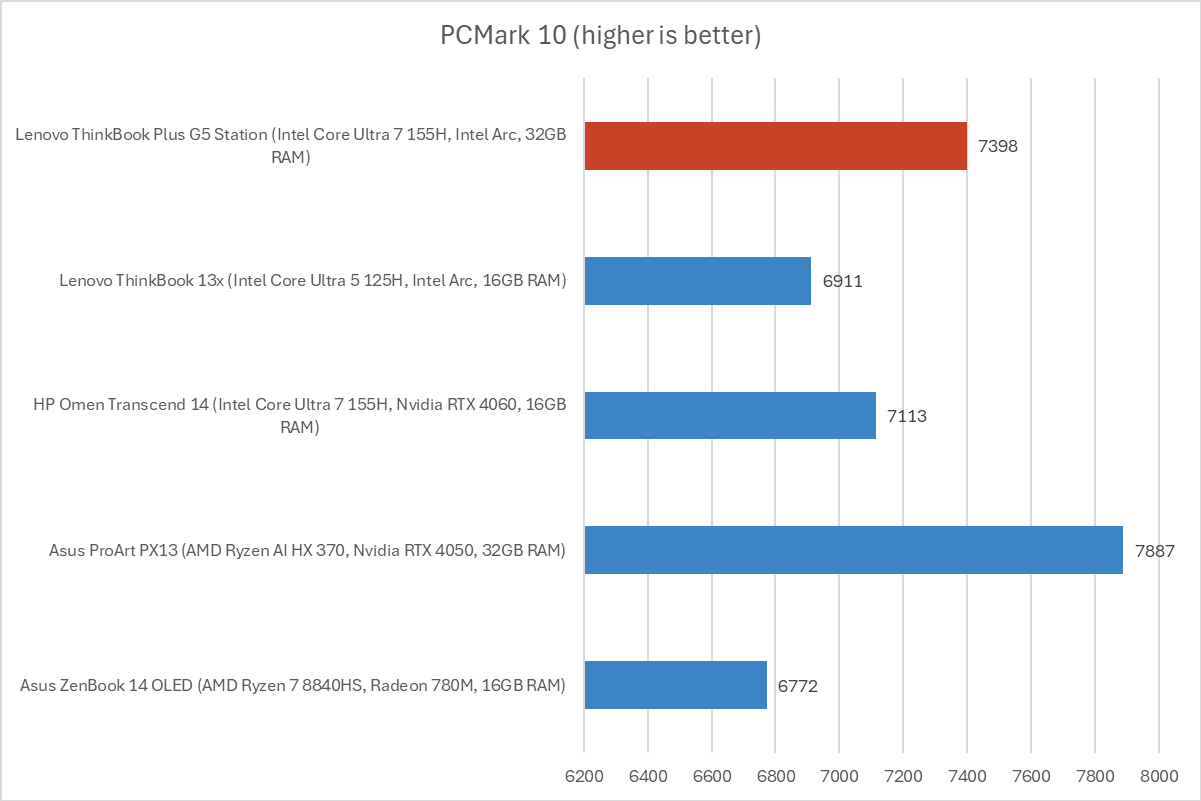

IDG / Chris Hoffman

IDG / Chris Hoffman
IDG / Chris Hoffman
First, we run PCMark 10 to get an idea of overall system performance. In this benchmark, the Lenovo ThinkBook Plus Gen 5 Hybrid delivered a very respectable score of 7,398 and beat out other Intel Core Ultra 7 155H-powered systems.


IDG / Chris Hoffman

IDG / Chris Hoffman
IDG / Chris Hoffman
Next, we run Cinebench R20. This is a heavily multithreaded benchmark that focuses on overall CPU performance. It’s a quick benchmark, so cooling under extended workloads isn’t a factor. But, since it’s heavily multithreaded, CPUs with more cores have a huge advantage.
With an average score of 5,181, the Gen 5 Hybrid falls behind some similar laptops here, including the HP Omen Transcend 14 gaming laptop, which is also a 14-inch laptop and has a similar CPU.
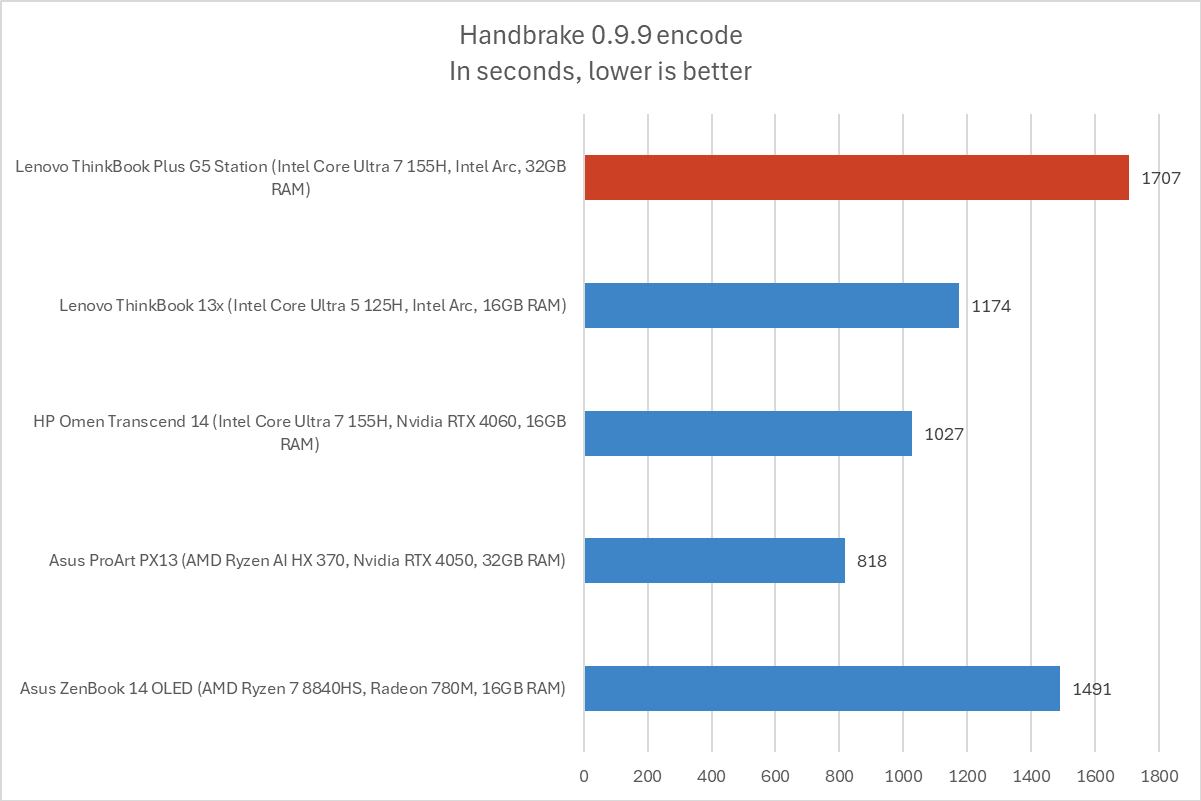

IDG / Chris Hoffman

IDG / Chris Hoffman
IDG / Chris Hoffman
We also run an encode with Handbrake. This is another heavily multithreaded benchmark, but it runs over an extended period. This demands the laptop’s cooling kick in, and many laptops will throttle and slow down under load.
The ThinkBook Plus Gen 5 Hybrid completed the encode process in 1,707 seconds, which is about 28 and a half minutes. That’s a rather low score compared to other laptops with the same CPU and suggests thermal throttling under load here. This machine likely isn’t the ideal workhorse system if you’re performing CPU-heavy tasks and need sustained high CPU performance. (On the other hand, the PCMark 10 score suggests it’s better than similar systems for general desktop productivity performance).
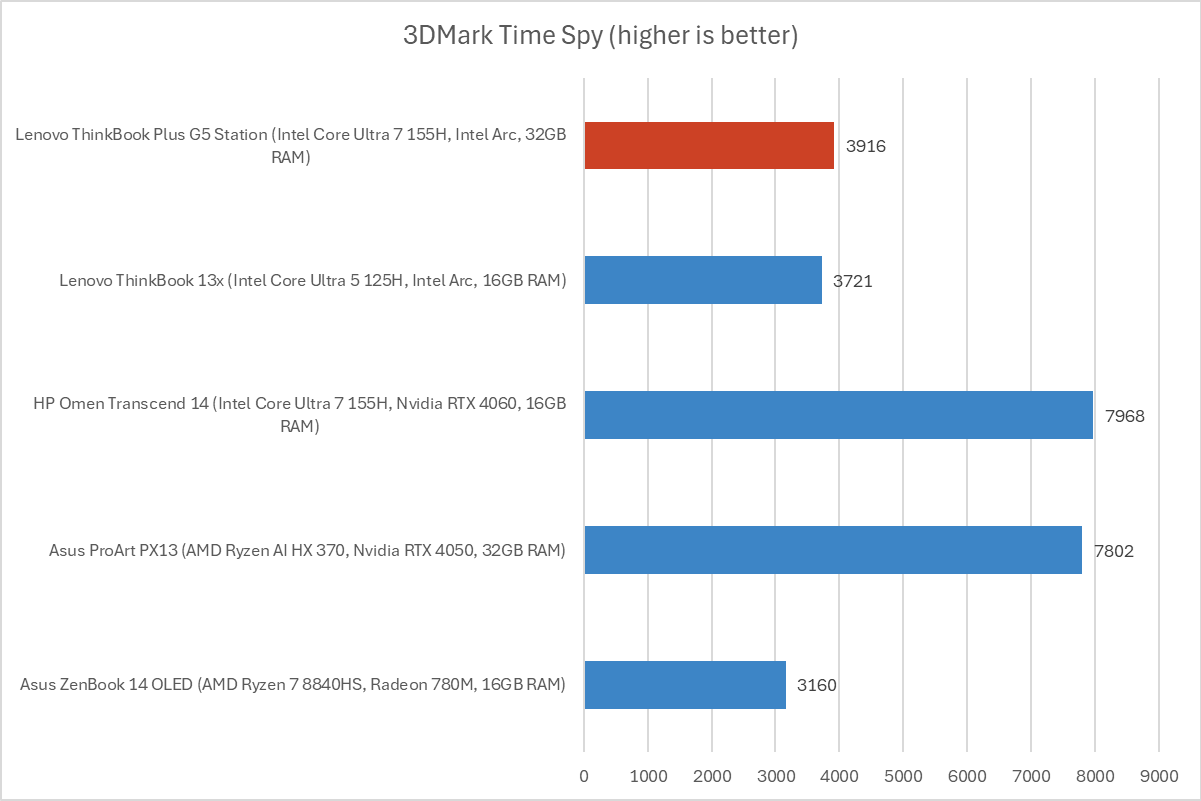

IDG / Chris Hoffman

IDG / Chris Hoffman
IDG / Chris Hoffman
Next, we run a graphical benchmark. This isn’t a gaming laptop, but it’s still good to check how the GPU performs. We run 3Dmark Time Spy, a graphical benchmark that focuses on GPU performance.
With a score of 3,916, this machine falls behind because of its Intel Arc graphics. The chart here shows how much more performance you can expect if you go for discrete Nvidia graphics in a laptop. However, unless you’re playing games on this laptop or using professional applications that need a GPU, you won’t notice a difference and the Intel Arc graphics will do the job well.
Overall, the Lenovo ThinkBook Plus Gen 5 Hybrid delivers fine overall application performance on par with many other Intel Meteor Lake-powered laptops. It’s not the ideal gaming laptop thanks to its CPU. And, due to the thermal throttling, it’s not the ideal system for people who need to perform demanding CPU-heavy tasks for long periods of time. But the day-to-day desktop application performance is very solid, as the PCMark 10 score highlights.
Lenovo ThinkBook Plus Gen 5 Hybrid: Battery life
The Lenovo ThinkBook Plus Gen 5 Hybrid includes a 75 Watt-hour battery. In day-to-day desktop use, it delivered similar battery life to many other Intel Core Ultra 7 155H laptops I’ve used. Battery life was reasonable — although, like most Intel Meteor Lake-powered PCs I’ve used, it didn’t quite deliver “all-day battery life” when using basic productivity applications like Microsoft Word, OneNote, Slack, and Google Chrome.


IDG / Chris Hoffman

IDG / Chris Hoffman
IDG / Chris Hoffman
To benchmark the battery life, we play a 4K copy of Tears of Steel on repeat in the Movies & TV app on Windows 11 with airplane mode enabled until the laptop suspends itself. We set the screen to 250 nits of brightness for our battery benchmarks. This is a best-case scenario for any laptop since local video playback is so efficient, and real battery life in day-to-day use is always going to be less than this. Also, this machine has an advantage in this benchmark because it has an OLED display, which means it uses less power to display the black bars beside the video during playback.
The Lenovo ThinkBook Plus Gen 5 Hybrid lasted for an average of 806 minutes in our battery life benchmark. That’s nearly 13 and a half hours. Of course, you won’t get that much battery life in real use.
It’s worth noting that Lenovo says you’ll get better battery life when using the laptop as an Android laptop instead of a Windows laptop. So, when the battery is getting low, you could switch to an Android experience to prolong your usage.
Lenovo ThinkBook Plus Gen 5 Hybrid: Conclusion
The Lenovo ThinkBook Plus Gen 5 Hybrid is a very cool machine. I’m glad Lenovo is creating interesting and unique experiences like this one and bringing them to market. (I was also impressed by the dual-screen Lenovo Yoga Book 9i laptop, which I reviewed earlier this year).
The elephant in the room is the price. $3,518 is a lot of money for a laptop. For that much money, you could get both a capable Windows laptop and a high-quality Android tablet. You could use both devices at once. In fact, you’d probably spend less than $3,518 on that dual-device setup – even if you splurged.
Many people looking at a machine like this one may prefer a 2-in-1 that runs Windows in both modes, like Microsoft’s Surface Pro. Other people may want a separate Windows laptop and Android tablet. Or, if you just want a laptop that runs Android apps, you may want to get a Chromebook.
I wish the mechanism for attaching the display worked more smoothly and didn’t feel so clunky to use. But I got used to it, and some people are going to love this machine. There’s nothing else like this on the market. If you want a two-in-one Windows and Android experience like this one, there’s no substitute.
Best Prices Today: Lenovo ThinkBook Plus Gen 5 Hybrid
RetailerPriceLenovo$3518View DealPrice comparison from over 24,000 stores worldwideProductPricePrice comparison from Backmarket
Author: Chris Hoffman, Contributor

Chris Hoffman is the author of Windows Intelligence, a free email newsletter that brings the latest Windows PC news, trips, and tricks to inboxes each week. He’s also the former editor-in-chief of How-To Geek and a veteran tech journalist whose work has appeared in The New York Times, PCMag, Reader’s Digest, and other publications.
Recent stories by Chris Hoffman:
What the heck is an NPU, anyway? Here’s an explainer on AI chipsAcer Chromebook Plus Spin 714 review: ChromeOS gets luxuriousAcer Nitro 14 review: Proof that gaming laptops don’t have to bankrupt you


